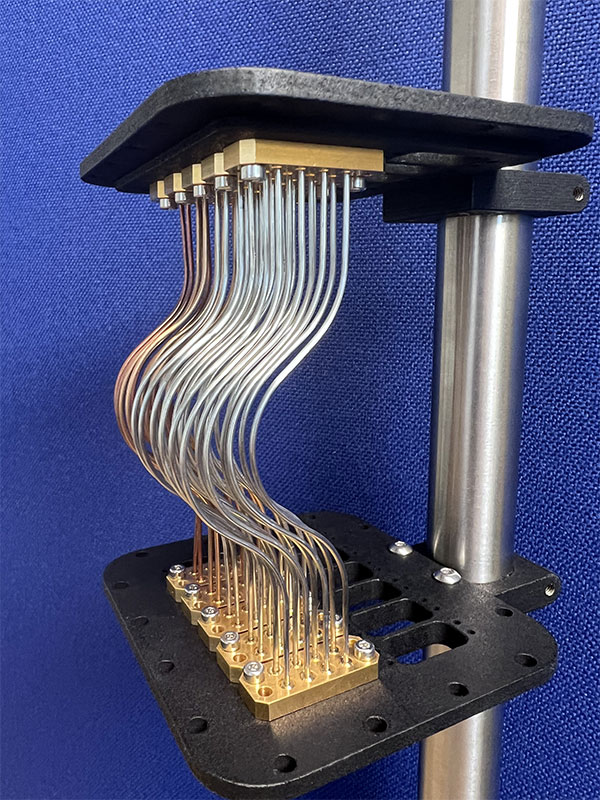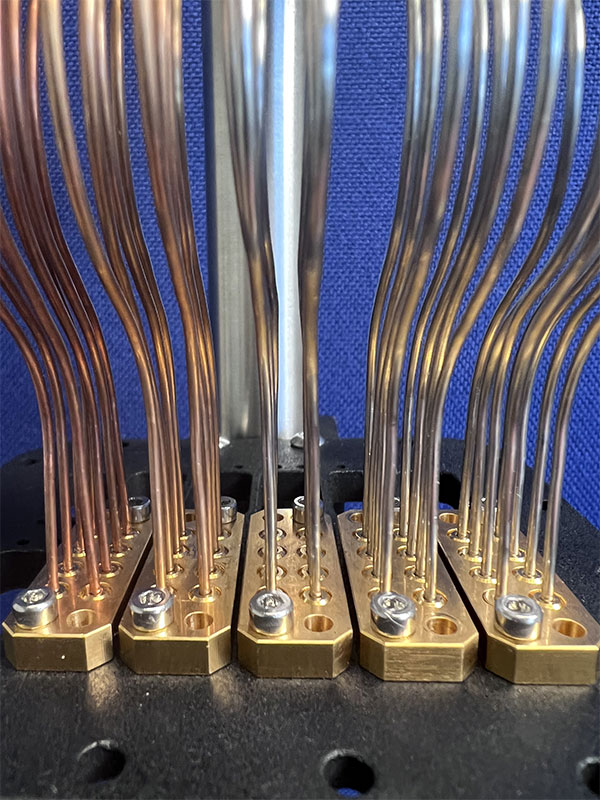With the increase in research of quantum computers and the development of large-scale high qubit machines, there’s a requirement for a large number of microwave cables necessary for control and readout lines to the quantum processor.
Microwave connectors and cable assemblies are used in quantum computing to transmit signals that manipulate the state of qubits; qubit manipulation is the mechanism that carries out quantum computing operations.
“These have traditionally been provided by individual coaxial cables fitted with SMA connectors, which offer limited packaging due to their 8mm hex coupling nut, also requiring space for the application of tooling during installation.” explains Martin Spooner Director Of Engineering at Intelliconnect (Europe) Ltd who RF Com has partnered for more than 20 Years.
High-density multiway connectors have been created by CryoCoax, a branch of Intelliconnect, based on the SMPM interface. These connectors not only allow many more coaxial lines to fit in a given area but also make installation and customization inside a dilution refrigerator much easier. These high-density connectors are built with a 4.75mm pitch, where the typical spacing when utilising SMA connectors is about 16mm, and with the SMPM interface, connecting the two fasteners is as easy as pushing them together and tightening them with a hex key.

Quantum processors are required to operate at temperatures near absolute zero within a dilution refrigerator (DR). A typical dilution refrigerator has a vacuum-sealed top plate and a number of cooling stages below this, reaching temperatures below 20mK at the lowest stage.
In order to reduce heat transfer, each cooling stage is separated by a bulkhead or heatshield. Between each of these stages, cables are connected by feedthrough connectors to provide good thermalization. Both the heat load on the dilution refrigerator and thermal noise within the system can be reduced by thoroughly thermalizing cables, attenuators, and microwave components at the various temperature levels.
“Glass hermetic seals provide the vacuum-tight seal at the top of the DR with hermeticity of 1×10^(-8) CC He/Sec at 1 Atm. These can be incorporated into custom-designed top plates as well as standard ISO or KF style plates. A typical ISO 100 plate can support up to 120 coax lines depending on connector configuration. Custom plates are capable of supporting many more coax lines.” according to Martin
CryoCoax use standard non-hermetic feedthrough plates between the various cooling stages, which are simply machined with mounting holes to accept the connectors. The connector body incorporates a flange that tightens against the top or bottom face of the plate to provide thermalisation and to close off any radiation path.
‘Coax Sticks’ as they are known are top to bottom assemblies which can be fully customised with attenuator blocks and a full complement of cable types and materials, to provide connections from room temperature, through all of the cooling stages down to low-temperature level. These undergo RF testing at room temperature, and test data is provided for DC Resistance, Return Loss, Insertion Loss up to 40GHz, although most applications operate at frequencies much lower than this in Quantum Computing.
The connector components are machined from high-purity copper and beryllium copper and are gold plated to provide the best thermal conductivity. Non-magnetic versions can also be specified if required.

The connectors are compatible with .047” (1.19mm) size coax, either semi-rigid, flexible or conformable versions are available. The Semi-rigid cables are available in niobium-titanium, stainless steel, copper, cupronickel and beryllium copper as well as combinations of these with silver-plated conductors, providing the user with a large choice in terms of thermal conductivity and attenuation.
Flexible cables with silver-plated copper conductors are typically used for connections from the top of the DR to connect the control electronics at room temperature and can be terminated with conventional SMA connectors. Conformable copper coax options are also available and are often used at the lowest stage.
Superconducting niobium-titanium cables are often specified in quantum applications. This material can be challenging, if not impossible to solder. To overcome this, CryoCoax developed solderless connections for these high-density connectors as well as the traditional SMA, 2.92 & SMP connectors.

Standard configurations are 8-way, 16-way and 24-way with either smooth bore or full detent options. Connector blocks can be ganged together to potentially give hundreds of coax lines in a DR. Two connector blocks form a mated pair, one having a full detent male SMPM interface, and the other a smooth bore SMPM male interface.
These are used in conjunction with ‘bullet’ style female to female SMPM adaptors fitted between a pair of connector blocks. The ‘bullet’ adaptors are retained in the full detent connector block. These can be combined with 8-way, 16-way and 24-way attenuator blocks available in 0dB, 3dB, 6dB, 10dB and 20dB.
This article contains excerpts from Martin Spooners Blog post from August 26 2021 and are included with thanks.
Contact any of the RF Com Team for more information about our Cryo and Quantum capabilities




